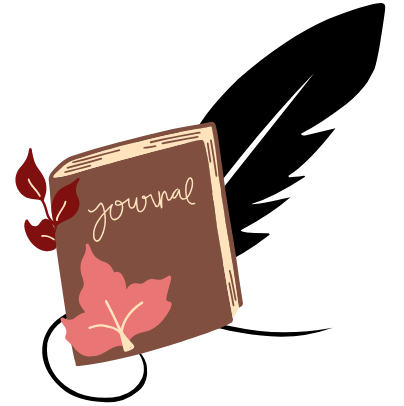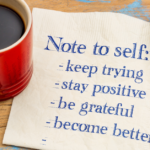Introduction
I’ve always been captivated by the transformative power of journaling. There’s an undeniable magic in the act of putting pen to paper and watching your thoughts unfold before your eyes.
However, facing a blank page can be daunting for many.
This is where guided journals step in, offering a structured pathway to self-discovery and personal growth.
Guided journals are far more than simple notebooks. They are meticulously crafted tools designed to help you explore your inner world, set meaningful goals, and track your progress over time.
Whether you’re a seasoned writer or new to journaling, these books provide a roadmap for personal development that can benefit anyone looking to enhance their self-awareness and achieve their goals.
The Science Behind Guided Journaling
You might be wondering if this journaling “stuff” actually works. The short answer is a resounding yes.
Numerous scientific studies have demonstrated the positive impact of regular journaling on mental health, emotional well-being, and even physical health.
A particularly compelling study published in the journal Advances in Psychiatric Treatment found that expressive writing (a form of journaling) for just 15-20 minutes a day, three to five times a week, can significantly improve both physical and psychological health. Participants reported reduced stress levels, improved immune function, and even fewer visits to the doctor.
Guided journals take this concept a step further. By providing structured prompts and exercises, they help focus your thoughts and reflections on specific areas of personal growth.
This targeted approach often leads to more profound insights and lasting change.
How Guided Journals Differ from Traditional Journaling
Traditional journaling typically involves free-form writing about your thoughts, feelings, and experiences. While this can be useful, it can also lead to aimless rambling or getting stuck in negative thought patterns.
Guided journals, on the other hand, provide a framework for your reflections.
These journals often include:
- Thought-provoking prompts: Questions or statements that encourage deep reflection on specific topics.
- Structured exercises: Activities designed to help you explore different aspects of your personality, goals, or challenges.
- Goal-setting frameworks: Tools to help you identify, plan for, and track progress towards your goals.
- Gratitude practices: Prompts that encourage you to focus on the positive aspects of your life.
- Mindfulness exercises: Activities that help you stay present and aware of your thoughts and feelings.
By providing this structure, guided journals help you focus your reflections and make the most of your journaling time.
Choosing the Right Guided Journal
With the abundance of options available, selecting the right guided journal can feel overwhelming. Here are some key factors to consider when making your choice:
Focus Area
Guided journals often have specific themes or goals. Some popular options include:
- Gratitude journals: These focus on cultivating a sense of appreciation for the good things in your life.
- Goal-setting and productivity journals: Designed to help you clarify your goals and create actionable plans to achieve them.
- Mindfulness and meditation journals: These guide you through practices to increase present-moment awareness and reduce stress.
- Emotional intelligence journals: Focused on helping you understand and manage your emotions more effectively.
- Creative writing journals: These provide prompts and exercises to spark your imagination and improve your writing skills.
Consider what area of your life you’d like to focus on and choose a journal that aligns with those goals.
Structure
Some journals offer daily prompts, while others are designed for weekly or monthly reflection. Think about your schedule and how much time you can realistically commit to journaling.
If you’re new to the practice, starting with a less demanding structure might be more sustainable.
Format
Do you prefer open-ended questions or more structured exercises? Some journals include space for free writing, while others have specific activities or even coloring pages.
Consider your personal preferences and what type of format will keep you engaged.
Length
Consider how long you want to use the journal. Some are designed for a specific time frame (e.g., 90 days), while others can be used indefinitely.
If you’re just starting out, a shorter-term journal might be less intimidating and help you build the habit.
Making the Most of Your Guided Journal
Once you’ve chosen your journal, here are some tips to help you get the most out of the experience:
Set a Regular Time
Consistency is key when it comes to journaling. Try to set aside a specific time each day or week for your practice.
Many people find that journaling first thing in the morning or right before bed works well.
Experiment to find what fits best with your schedule and energy levels.
Create a Ritual
Make your journaling time special by creating a ritual around it. Find a comfortable spot, light a candle, brew your favorite tea, or play some soothing music.
This can help signal to your brain that it’s time to reflect and focus inward, making it easier to transition into a reflective mindset.
Be Honest
Remember, this journal is for your eyes only. Don’t censor yourself or try to write what you think you “should” be feeling.
The most valuable insights often come from raw, unfiltered thoughts.
Give yourself permission to be completely honest on the page.
Don’t Skip the Hard Stuff
It’s tempting to avoid prompts or questions that make you uncomfortable. But these are often the ones that lead to the most growth.
Push yourself to explore difficult emotions or challenging topics.
You might be surprised by the insights you gain when you lean into discomfort.
Review Regularly
Set aside time periodically to look back through your journal entries. You might be surprised at the patterns you notice or the progress you’ve made.
This review process can help reinforce positive changes and provide motivation to continue your journaling practice.
Common Challenges and How to Overcome Them
Even with the structure of a guided journal, you might encounter some roadblocks. Here are some common challenges and strategies to address them:
Writer’s Block
If you’re struggling to respond to a prompt, try free writing for a few minutes. Just let your thoughts flow without judgment.
You can also try answering the prompt out loud first, then writing down your response.
Sometimes, hearing your thoughts spoken aloud can help clarify them.
Lack of Time
If you’re having trouble finding time to journal, start small. Even five minutes a day can be beneficial.
You could also try journaling during your commute or lunch break.
Remember, consistency is more important than length. A short daily entry is often more valuable than a long, infrequent one.
Perfectionism
Remember, your journal doesn’t have to be perfect. It’s not about creating a literary masterpiece – this involves self-reflection and growth.
Embrace the messiness of your thoughts.
If you find yourself getting stuck on making everything “just right,” try setting a timer and writing without stopping until it goes off.
Lack of Privacy
If you’re worried about others reading your journal, consider keeping it in a secure place or using a digital journaling app with password protection. Some people also find it helpful to write in code or use abbreviations for sensitive information.
Advanced Techniques for Deeper Insights
Once you’ve gotten comfortable with basic guided journaling, you might want to explore some more advanced techniques:
Shadow Work
Shadow work involves exploring the parts of yourself that you typically keep hidden or repressed. This can include negative traits, fears, or wants that you’re not comfortable acknowledging. While it can be challenging, shadow work can lead to profound self-understanding and personal growth.
To incorporate shadow work into your journaling practice, try prompts like:
- What parts of myself do I try to hide from others?
- What traits in others trigger strong negative reactions in me?
- If I could change one thing about myself, what would it be and why?
Future Self Journaling
Future self journaling involves imagining yourself in the future and writing from that perspective. This technique can help clarify your goals and motivate you to work towards them.
It can also help you identify potential obstacles and plan how to overcome them.
Try writing a letter to your current self from your future self, describing what you’ve accomplished and how you got there. Or, write about a typical day in your ideal future, including as many details as possible.
Dialogue Journaling
Dialogue journaling involves having a conversation with different parts of yourself on the page. This can help you understand internal conflicts and find resolution.
You might have a dialogue between your logical and emotional sides, or between your present self and your future self.
To try this technique, start by identifying two perspectives or parts of yourself that you want to explore. Write out a conversation between them, alternating between each voice.
Let the dialogue flow naturally, and see what insights emerge.
The Role of Technology in Guided Journaling
While traditional pen-and-paper journaling has it’s charms, digital options are becoming increasingly popular. Many guided journal apps offer features like:
- Customizable prompts
- Mood tracking
- Goal setting and progress monitoring
- Multimedia integration (photos, audio, etc.)
- Data analysis to identify patterns over time
These digital tools can add an extra layer of insight to your journaling practice. For example, mood tracking apps can help you identify patterns in your emotional state over time, while goal-setting features can help you stay accountable to your goals.
However, it’s important to choose what works best for you. Some people find that the act of physically writing helps them connect more deeply with their thoughts.
Others appreciate the convenience and extra features of digital journaling.
You might even find that a combination of both works well for you.
Integrating Journaling with Other Personal Growth Practices
Guided journaling can be a powerful tool on it’s own, but it becomes even more effective when combined with other personal growth practices. Consider integrating your journaling with:
Meditation or Mindfulness Exercises
Use your journal to reflect on your meditation experiences or to record mindfulness observations. You might write about insights that arise during meditation or use your journal to practice mindful writing.
Therapy or Counseling
Your journal can be a valuable tool to supplement therapy sessions. Use it to explore themes that come up in therapy, prepare topics you want to talk about, or reflect on your progress between sessions.
Goal-Setting and Planning Sessions
Use your journal to brainstorm goals, create action plans, and track your progress. Regular journaling can help you stay focused on your goals and identify any obstacles that arise.
Creative Activities
Combine your journaling with other creative practices like art or music. You might use your journal to sketch ideas, write song lyrics, or reflect on your creative process.
Physical Exercise or Yoga
Use your journal to track your fitness goals, reflect on how different types of exercise affect your mood, or explore the mind-body connection through your yoga practice.
The insights you gain from journaling can tell these other practices, and vice versa, creating a holistic approach to personal growth.
The Long-Term Benefits of Guided Journaling
Consistent guided journaling can lead to many long-term benefits:
Improved Self-Awareness
Regular reflection helps you understand your thoughts, feelings, and behaviors more deeply. This increased self-awareness can lead to better decision-making and more authentic living.
Enhanced Emotional Intelligence
By regularly exploring and expressing your emotions through journaling, you can become more adept at recognizing and managing your feelings. This can lead to improved relationships and better emotional regulation.
Clearer Goal Setting and Achievement
Guided journals often include exercises for setting and tracking goals. This structured approach can help you clarify what you want to achieve and create actionable plans to get there.
Stress Reduction
The act of writing down your thoughts and feelings can be cathartic, helping to reduce stress and anxiety. Over time, this can lead to improved mental health and overall well-being.
Improved Problem-Solving Skills
Journaling encourages you to look at situations from different perspectives and explore various solutions. This can enhance your problem-solving abilities in all areas of life.
Increased Gratitude
Many guided journals include gratitude exercises. Regularly practicing gratitude has been shown to increase happiness, improve relationships, and even boost physical health.
Better Memory and Cognitive Function
The act of writing by hand has been linked to improved memory and cognitive function. Regular journaling can help keep your mind sharp as you age.
Overcoming Common Misconceptions About Journaling
Despite it’s many benefits, some people are hesitant to start journaling because of common misconceptions. Let’s address a few of these:
“I’m not a good writer”
Journaling isn’t about perfect grammar or flowery prose. It’s about self-expression and reflection.
Your journal is for your eyes only, so don’t worry about how it sounds or looks.
“I don’t have anything interesting to write about”
Your life and thoughts are inherently interesting and worthy of exploration. Guided journals provide prompts and exercises to help you look further, even on days when you feel like you have nothing to say.
“I don’t have time to journal”
Even a few minutes of journaling can be beneficial. Start small with just 5-10 minutes a day, and you’ll likely find that you naturally want to spend more time with your journal as you see the benefits.
“Journaling is just rehashing negative thoughts”
While it’s true that journaling can be a place to process difficult emotions, it’s also a tool for cultivating gratitude, setting goals, and exploring positive aspects of your life. A well-structured guided journal helps ensure a balanced approach.
Getting Started with Your Guided Journal
Now that you understand the benefits and techniques of guided journaling, you might be eager to get started. Here are some steps to begin your journaling practice:
- Choose your journal: Based on the factors we discussed earlier, select a guided journal that aligns with your goals and preferences.
- Set an intention: Before you start, take a moment to think about what you hope to gain from your journaling practice.
This can help you stay motivated and focused.
- Start small: Begin with just a few minutes of journaling each day.
As you build the habit, you can gradually increase the time you spend writing.
- Be consistent: Try to journal at the same time each day to establish a routine.
- Be patient: Like any new habit, journaling takes time to feel natural.
Give yourself at least a month of consistent practice before evaluating it’s impact.
- Stay open: Approach your journaling practice with curiosity and openness.
You might be surprised by the insights that emerge.
Remember, there’s no “right” way to journal. The most important thing is to find a practice that works for you and helps you grow.
Key Takeaways
- Guided journals provide structure and focus for self-reflection and personal growth.
- Regular journaling has been scientifically proven to improve mental and physical health.
- Choose a journal that aligns with your specific goals and preferences.
- Consistency and honesty are key to getting the most out of your journaling practice.
- Don’t shy away from difficult topics – they often lead to the most significant insights.
- Advanced techniques like shadow work and future self journaling can deepen your practice.
- Consider integrating journaling with other personal growth practices for a holistic approach.
People Also Asked
What is a guided journal?
A guided journal is a structured notebook that provides prompts, exercises, and frameworks to help you reflect on specific topics or work towards particular goals.
How often should I write in a guided journal?
The frequency of journaling depends on your personal preferences and schedule. Many people find daily journaling most useful, but even 2-3 times a week can be effective.
Can guided journaling help with anxiety?
Yes, many people find that guided journaling can help reduce anxiety by providing a structured way to process thoughts and emotions.
What’s the difference between a guided journal and a regular journal?
A guided journal provides specific prompts and exercises, while a regular journal is typically blank, allowing for free-form writing.
How long should I spend journaling each day?
Even 5-10 minutes of journaling can be beneficial. The most important factor is consistency as opposed to length.
Can I use a digital app for guided journaling?
Yes, there are many digital apps available that offer guided journaling features. Choose the format that works best for you.
Is it okay to skip prompts in a guided journal?
While it’s best to try all prompts, it’s okay to skip ones that don’t resonate with you. The goal is to find what works best for your personal growth.
How do I choose the right guided journal for me?
Consider your personal goals, the journal’s focus area, it’s structure, and format when choosing a guided journal.
Can guided journaling replace therapy?
While guided journaling can be a valuable tool for self-reflection and growth, it’s not a substitute for professional mental health treatment when needed.
How long does it take to see benefits from guided journaling?
Many people report feeling benefits within a few weeks of consistent journaling, but it can vary from person to person.




